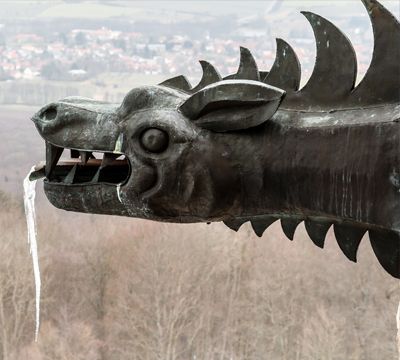History of Rain Gutters

Ancient Roman cistern, used for storing water.
Since ancient times, man has been channeling and collecting rain water for drinking, washing, and irrigation. As far back as 3000BC, the Harappan civilization was using water based toilets that were linked by drains. As civilization continued to develop, the need to shed rainwater away from building foundations became apparent. Roman architects used gutters on roadways and would also develop guttering along rooftops. Romans would sometimes store this water in giant cisterns to be used for bathing.
In the middle ages, Roman architecture made its way to Great Britain. Prominent structures like churches began being built with stone roofs which had built in gutter systems. Gargoyles were a popular decorative feature at the end of these systems, made to look as if they were spitting out the water. Around the same time, residential gutters began to develop from wood, usually cedar or hemlock.
In the middle ages, Roman architecture made its way to Great Britain. Prominent structures like churches began being built with stone roofs which had built in gutter systems. Gargoyles were a popular decorative feature at the end of these systems, made to look as if they were spitting out the water. Around the same time, residential gutters began to develop from wood, usually cedar or hemlock.
In the late 1700's, rain gutters began appearing in the new American Colonies, usually consisting of two boards shaped into a V. As metal become more available, gutters were lined with zinc, or made from lead. Later in the 1800's, cast iron and copper gutters began to replace the lead gutters.
The next major innovation in rain gutters came with the invention of seamless gutters in the 1960's. Using a roll forming machine and a coil of aluminum, gutters could be made on site to fit the exact dimensions of a structure, limiting seams and therefore leaks. It wasn't until the 1980's that seamless gutters became the standard affordable gutter system available to homeowners. It was also during this time that popular products for Gutter Protection began to find their way into the market. Today, seamless gutters come in a variety of colors, thicknesses, and styles, and the majority of gutters installed are seamless roll formed aluminum.
The next major innovation in rain gutters came with the invention of seamless gutters in the 1960's. Using a roll forming machine and a coil of aluminum, gutters could be made on site to fit the exact dimensions of a structure, limiting seams and therefore leaks. It wasn't until the 1980's that seamless gutters became the standard affordable gutter system available to homeowners. It was also during this time that popular products for Gutter Protection began to find their way into the market. Today, seamless gutters come in a variety of colors, thicknesses, and styles, and the majority of gutters installed are seamless roll formed aluminum.

European style gargoyle "spitting" rain water.

DESIGN. PROTECT. ENHANCE. SEAMLESSLY.
Featured links
Copyright © 2023
